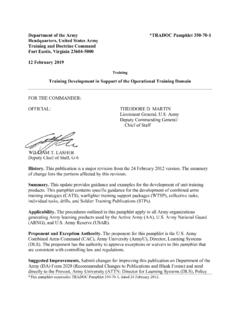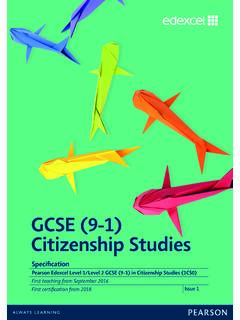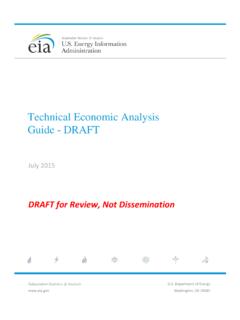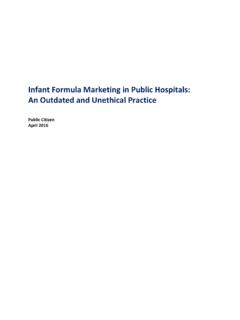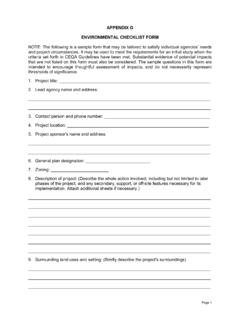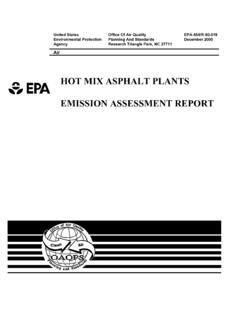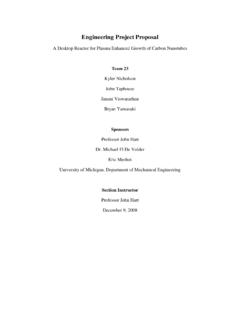Transcription of ENVIRONMENTAL ENGINEERING CONSIDERATIONS AND …
1 NOT MEASUREMENTSENSITIVEMIL-STD-810F1 January 2000 SUPERSEDINGMIL-STD-810E14 JULY 1989 DEPARTMENT OF DEFENSETEST METHOD STANDARDFORENVIRONMENTAL ENGINEERING CONSIDERATIONSAND LABORATORY TESTSAMSC N/AAREA ENVRDISTRIBUTION STATEMENT A: Approved for public release; distribution is January 2000 Part One-iiFOREWORDThis test method standard is approved for use by all Departments and Agencies of the Department of Defense (DoD).Although prepared specifically for DoD applications, this standard may be tailored for commercial applications aswell. MIL-STD-810F is a significant revision of MIL-STD-810E. Much of the standard is rewritten completely toprovide clearer direction. The primary emphases are still the same -- tailoring a materiel item's ENVIRONMENTAL designand test limits to the conditions that the specific materiel will experience throughout its service life, and establishinglaboratory test methods that replicate the effects of environments on materiel rather than trying to reproduce theenvironments themselves.
2 However, the "F" revision has been expanded significantly up front to explain how toimplement the ENVIRONMENTAL tailoring process throughout the materiel acquisition cycle. This revision recognizes that the ENVIRONMENTAL design and test tailoring process has expanded to involve a widerange of managerial and technical interests. Accordingly, this revision orients ENVIRONMENTAL design and testdirection toward three basic types of users who have distinctly different, although closely associated, interests: program managers who, among other responsibilities, ensure proposed concepts and systems are valid and functional inintended operational environments; ENVIRONMENTAL ENGINEERING specialists (EES), who enter the acquisition process earlyto assist combat and materiel developer tailoring efforts by preparing life cycle ENVIRONMENTAL profiles and draftingtailored design criteria and test programs, and the design, test, and evaluation community, whose analysts, engineers, andfacility operators use tailored designs and tests to meet user needs.
3 The most visible difference in the "F" revision is that the overall document is in two parts. Part One describes management, ENGINEERING , and technical roles in the ENVIRONMENTAL design and test tailoringprocess. It focuses on the process of tailoring materiel design and test criteria to the specific environmentalconditions a materiel item is likely to encounter during its service life. New appendices support the succinctlypresented text of Part One. appendix A contains complete descriptions of ENVIRONMENTAL ENGINEERING tasks. Thesetasks, along with management information in appendix B and EES guidance in appendix C, will help to ensure theenvironmental design and test tailoring process is implemented and documented according to the disciplined, butflexible approach to materiel acquisition called for in Department of Defense (DoD) 5000-series documents ( , ).
4 Terms used in this standard relating to the materiel acquisition process are limited to terms used in theDoD 5000-series documents; to avoid confusion and promote simplicity, service-specific terms/processes are Two contains ENVIRONMENTAL laboratory test methods to be applied according to the general and specific testtailoring guidelines described in Part One. It is important to emphasize that these methods are not to be called out inblanket fashion nor applied as unalterable routines, but are to be selected and tailored to generate the most relevanttest data support the tailoring process described in Part One, each test method in Part Two contains some environmentaldata and references, and identifies tailoring opportunities for the particular method. Some methods afford a widelatitude for tailoring; some can be tailored up to established limits, and some have relatively few tailoring options.
5 Whenever possible, each method contains background rationale to help determine the appropriate level of tailoring. Each test method supports the test engineer and test facility operator by describing preferred laboratory test facilitiesand methodologies. Any specific tailoring information and values contained in these test methods should besupplanted by more up-to-date or program-specific information when applied properly, the ENVIRONMENTAL management and ENGINEERING processes described in this standard can beof enormous value in generating confidence in the ENVIRONMENTAL worthiness and overall durability of materielsystem design. However, it is important to recognize that there are limitations inherent in laboratory testing thatmake it imperative to use proper caution and ENGINEERING judgement when extrapolating these laboratory results toresults that may be obtained under actual service conditions.
6 In many cases, real-world ENVIRONMENTAL stresses(singularly or in combination) cannot be duplicated practically or reliably in test laboratories. Therefore, usersMIL-STD-810F1 January 2000 Part One-iiishould not assume that a system or component that passes laboratory tests of this standard also would pass field/fleetverification US Department of Defense would like to thank the following individuals for their contributions toward thedevelopment and publication of MIL-STD-810F:Anderson, Andy United DefenseMerritt, Ron US Navy, Naval Air Warfare CenterBair, Jim US Air Force, Wright-Patterson AFBM oriceau, Jacques LRBA, FranceBell, Dwayne US Air Force, Eglin AFBMoss, Ron Ordnance Board, United KingdomCaruso, Hank G s and DegreesSullivan, Jamie US Army, Redstone Technical Test CenterConnon, Skip US Army, Aberdeen Test CenterTanner, Steve US Navy, Naval Air Warfare CenterEgbert, Herb US Army Developmental Test CommandWalton, Scott US Army, Aberdeen Test CenterGalloway, Judy US Army, Aberdeen Test CenterWeaver, Earl US Air Force, Wright-Patterson AFBH enry, Connie US Air Force, Wright-PattersonAFBW illiamson, Roger US Army Test and EvaluationCommandMacMartin, Dave National Defence Headquarters,CanadaAlso, a special thank you to Herb Egbert.
7 Chairman of the MIL-STD-810 revision committee for his leadership,dedication, and perseverance in revising this standard is intended to be a "living document" that will be updated as new concepts, technologies, andmethodologies evolve. Address beneficial comments (recommended changes, additions, deletions) along with clear,supporting rationale and any pertinent data that may improve this document to: ASC/ENOI, Bldg. 560, 2530 LoopRoad West, Wright-Patterson AFB OH 45433-7101. Use the Standardization Document Improvement Proposal(DD Form 1426) appearing at the end of this document or send a letter detailing the paragraph/page number,recommended wording, and reason/rationale for the technical questions to the following offices:Aeronautical Systems Center, ATTN: ASC/ENFS, 2530 Loop Road West, Wright-Patterson AFB OH 45433-7101;Commercial Tel: (937) 255-8357/8596; DSN 785-8357/8596; Fax: (937) Air Warfare Center, Weapons Division, ATTN: Code 476400D, China Lake CA 93555-6100; CommercialTel: (619) 939-4667; DSN 437-4667; Fax: (619) Army Developmental Test Command, 314 Longs Corner Road, ATTN: CSTE-DTC-TT-M, Aberdeen ProvingGround MD 21005-5055; Commercial Tel: (410) 278-1476; DSN 298-1476.
8 Fax: (410) 278-4243 January 2000 Part One-ivTHIS PAGE INTENTIONALLY BLANKMIL-STD-810F1 January 2000 Part One-vPART ONE -- ENVIRONMENTAL ENGINEERING PROGRAM GUIDELINESTABLE OF CONTENTSP aragraph .. DOCUMENTS .. Documents.. government documents.. Documents.. of .. PROGRAM Managers.. of the program manager.. for program managers.. Need Statement (MNS).. Requirements Document (ORD).. ENGINEERING Management Plan (SEMP).. and Evaluation Master Plan (TEMP).. and Operational Effectiveness Analysis (COEA).. ENGINEERING Specialists (EES).. of ENVIRONMENTAL ENGINEERING specialists.. ENGINEERING tailoring tasks.. an ENVIRONMENTAL ENGINEERING Management Plan (EEMP), Task an ENVIRONMENTAL Test and Evaluation Master Plan (ETEMP).. Defining a Life Cycle ENVIRONMENTAL Profile (LCEP), Task 402.. Developing Operational Environment Documentation (OED), Task 403.
9 Developing an ENVIRONMENTAL Issues/Criteria List (EICL), Task 404.. a Detailed ENVIRONMENTAL Test Plan (DETP), Task 405.. an ENVIRONMENTAL Test Report (ETR), Task 406.. and Test Engineers and Facility Operators.. of design engineers.. of test engineers/facility operators.. for design and test engineers and test facility operators.. environment (field/fleet) testing.. testing.. LABORATORY TEST METHOD GUIDELINES.. Ambient Test Conditions.. for Test Conditions.. 15 MIL-STD-810F1 January 2000 Part One-viTABLE OF CONTENTS (CONT D).Paragraph Instrumentation.. for environment.. Test Temperature.. item operating.. item non-operating.. Sequence.. Level Derivation.. Information for Facility Operators.. the test item in test Test item operation.. Baseline Data.. During Test.. Tests.. interruptions.
10 Interruptions for methods 503, 506, 510, 511, 514, 515, 516, 517, 519, 522,and 523.. interruptions for methods 500, 501, 502, 504, 505, 507, 508, 509, 512, 513,518, 520, and 521.. Data.. Effects and Failure Criteria.. Test Reports.. Purity.. of .. test chamber parameters.. the item under test.. of DoDISS.. Term (key word) Listing (Also see, Subject Index, page Index 1).. Standardization from Previous 24 FIGURES1-1 ENVIRONMENTAL ENGINEERING program guide .. viii1-2 Roles of acquisition personnel in ENVIRONMENTAL design/test tailoring process .. 24-1 ENVIRONMENTAL test program tailoring 84-2aGeneralized life cycle histories for military hardware .. 134-2bGeneralized life cycle histories for military hardware .. 145-1 Interrupted test cycle logic, Method 503, 506, 510, 511, 514, 516, 517, 519, 522, and 523 .. 20 MIL-STD-810F1 January 2000 Part One-viiTABLE OF CONTENTS Continued APPENDIXPageAEnvironmental Management and ENGINEERING Tasks.
